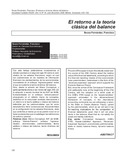| dc.rights.license | http://creativecommons.org/licenses/by-nc-sa/3.0/ve/ | |
| dc.contributor.author | Sousa Fernández, Francisco | |
| dc.date.accessioned | 2010-06-02T23:20:26Z | |
| dc.date.available | 2010-06-02T23:20:26Z | |
| dc.date.issued | 2010-06-02T23:20:26Z | |
| dc.identifier.issn | 1316-8533 | |
| dc.identifier.uri | http://www.saber.ula.ve/handle/123456789/31142 | |
| dc.description.abstract | Con este trabajo pretendemos incorporarnos al debate suscitado a lo largo del siglo XX sobre el valor relativo de los estados financieros, según el cual han predominado en los modelos de información financiera los planteamientos de los economicistas, concretados en el enfoque “ingresos-gastos” sobre el que se sustenta la teoría dinámica del balance. Pero, desde la emisión del Marco Conceptual, y particularmente ahora a los inicios del siglo XXI con la adopción a escala mundial de las NIIF del IASB, fundamentadas en el enfoque “activos-pasivos” propugnado en el referido marco de conceptos, asistimos en la comunidad contable internacional a un retorno a la teoría estática o clásica del balance defendida por los patrimonialistas, que tal como estudiaremos tiene consecuencias trascendentales en la configuración de los estados financieros, dado que conforme al mismo ya no se podrán incluir en el balance elementos que no satisfagan las definiciones
de activos y pasivos. | es_VE |
| dc.language.iso | es | es_VE |
| dc.rights | info:eu-repo/semantics/openAccess | |
| dc.subject | Marco conceptual | es_VE |
| dc.subject | NIIF del IASB | es_VE |
| dc.subject | Enfoque “Activos-Pasivos” | es_VE |
| dc.subject | Enfoque “Ingresos-Gastos” | es_VE |
| dc.subject | Economicistas | es_VE |
| dc.subject | Patrimonialistas | es_VE |
| dc.subject | Teoría estática o clásica del balance | es_VE |
| dc.subject | Teoría dinámica del balance | es_VE |
| dc.title | El retorno a la teoría clásica del balance | es_VE |
| dc.title.alternative | The return to the classic balance theory | es_VE |
| dc.type | info:eu-repo/semantics/article | |
| dc.description.abstract1 | The aim of this paper is to join the debate raised over the course of the 20th Century about the relative value of the financial statements, according to which the financial reporting models of the economicists have predominated, materialised in the form of the “revenues-expenses” approach which supports the Dynamic Balance Theory. But, since the arrival of the Conceptual Framework and particularly now, at the beginning of the 21st Century, with the adoption on a world scale of the IASB’s IFRS based on the “assets-liabilities” approach advocated in the aforementioned framework of concepts, in the international accounting community we are witnessing a return to the Static or Classic Balance Theory, upheld by the patrimonialists, which as we will see it has far-reaching implications for the composition of financial statements, given
that it will not allow items in the balance sheet that do not satisfy the asset and liability definitions. | es_VE |
| dc.description.colacion | 120-132 | es_VE |
| dc.description.email | sousaf@unican.es | es_VE |
| dc.identifier.depositolegal | 199802ME395 | |
| dc.subject.departamento | Departamento de Contabilidad y Finanzas | es_VE |
| dc.subject.facultad | Facultad de Ciencias Económicas y Sociales | es_VE |
| dc.subject.keywords | Conceptual framework | es_VE |
| dc.subject.keywords | IASB’s IFRS | es_VE |
| dc.subject.keywords | “Assets-Liabilities” approach | es_VE |
| dc.subject.keywords | “Revenues-Expenses” approach | es_VE |
| dc.subject.keywords | Economicists | es_VE |
| dc.subject.keywords | Patrimonialists | es_VE |
| dc.subject.keywords | Static or classic balance theory | es_VE |
| dc.subject.keywords | Dynamic balance theory | es_VE |
| dc.subject.publicacionelectronica | Revista Actualidad Contable FACES | |
| dc.subject.seccion | Revista Actualidad Contable FACES: Artículos | es_VE |
| dc.subject.thematiccategory | Ciencias Económicas y Sociales | es_VE |
| dc.subject.tipo | Revistas | es_VE |
| dc.type.media | Texto | es_VE |



